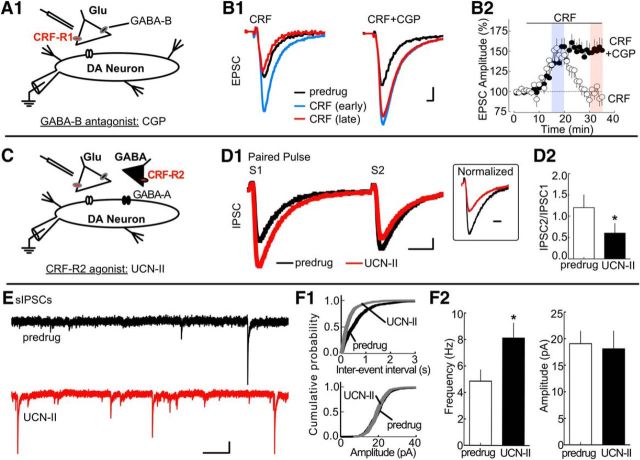Figure 4.
CRF-R2 stimulation reduces EPSCs by promoting GABA release. A, Simplified VTA circuit diagram. The hypothesized location of CRF-R1 is shown. B1, Left, Sample AMPA receptor EPSCs showing application of 100 nm CRF potentiated EPSCs during the early time period but inhibited EPSCs during later time periods. Right, Similar current traces in a different cell showing that inclusion of the GABA-B receptor antagonist CGP55845 (CGP; 10 μm) prevented the CRF attenuation of the EPSC. Calibration: 100 pA, 1 ms. B2, Time course summarizing the effect of CGP on the late-phase CRF attenuation (sample size for CRF and CRF + CGP: n = 8 cells, 4 rats per group). C, Simplified VTA circuit diagram. In this and subsequent figures, black triangles represent GABAergic synaptic terminals. The hypothesized location of CRF-R2 in relation to presynaptic GABA-B receptors on glutamatergic terminals is shown. D1, Left, Sample IPSC traces evoked with paired-pulse stimulation showing application of the CRF-R2 agonist UCN-II (100 nm) potentiates GABA-A receptor-mediated IPSCs. Inset, The second EPSC (S2) after normalization showing a commensurate shift of the PPR of an IPSC toward facilitation in the presence of 100 nm UCN-II. Calibration: S1/S2, 50 pA, 10 ms; inset, 5 ms. D2, Bar graph noting that the mean PPR of IPSCs shifts toward facilitation during CRF-R2 activation. *p = 0.0023 (n = 8 cells, 4 rats). E, The frequency of sIPSCs is potentiated by UCN-II (100 nm). Calibration: 50 pA, 0.5 s. F1, Analysis of sIPSCs illustrates that UCN-II (100 nm) altered the interevent interval distribution curve (top, Kolmogorov–Smirnov test, p = 0.0008) but did not alter the cumulative probability plot for sIPSC amplitude (bottom, Kolmogorov–Smirnov test, p = 0.14). F2, Bar graph summary of sIPSCs (sample size: n = 11 cells, 7 rats). UCN-II (100 nm) altered the average sIPSC frequency (left; *p = 0.0114), but not the average sIPSC amplitude (right; p = 0.3725, not significant).

